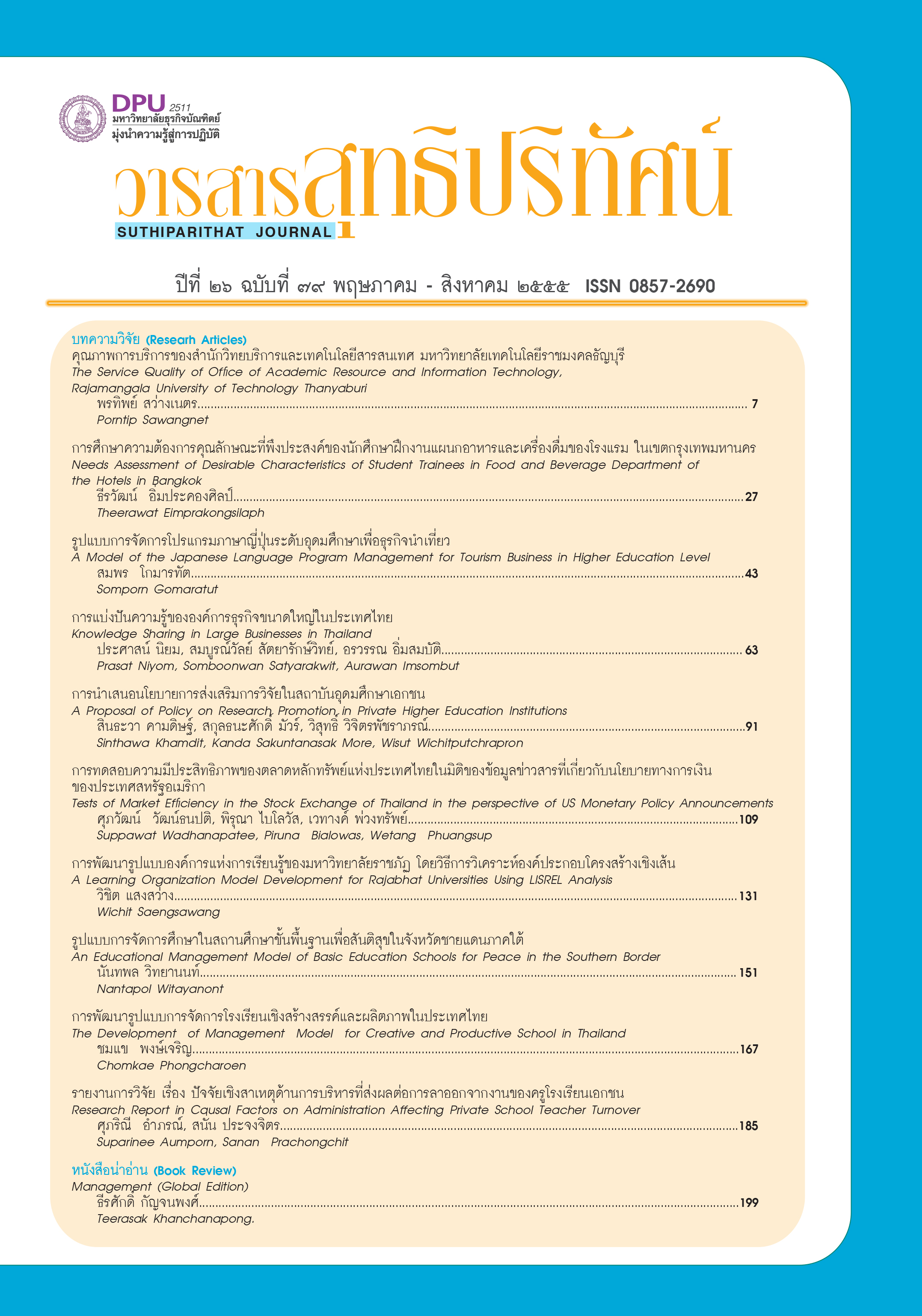RESEARCH REPORT IN CAUSAL FACTORS ON ADMINISTRATION AFFECTING PRIVATE SCHOOL TEACHER TURNOVER
Keywords:
Administrator leadership, conceptual role, organizational commitment, job satisfaction and private school teacher turnoverAbstract
The objectives of this research were to study and to propose a causal model of factors affecting private school teacher turnover. A sample of 718 was selected by means of multi-stage random sampling from teachers of general education private schools. The instrument used to collect the data was a set of questionnaires constructed by the researcher. The data from 611 usable questionnaire returns were analyzed by means of descriptive statistics and analyses of causal factor models by LISREL.
The major findings were as follows. The proposed causal model was consistent with the theory because the relative chi-square ratio (χ2/df) =0.27, goodness of fit indicators (GFI) =1.00, adjusted goodness of fit indicators (AGFI) =0.99, standardized RMR=0.018, CFI=1.00, RMSEA=0.00. All of the variables affected private school teacher turnover. The variables of administration directly affected private school teacher turnover at .05 level of significance were: administrator leadership, conceptual role, organizational commitment, and job satisfaction. The organizational commitment was negatively correlated with the private school teacher turnover. The administrator leadership, the conceptual role and the job satisfaction had a positive relationship with the private school teacher turnover. It showed that the administrator leadership and the conceptual role have little influence on the private school teacher turnover. The job satisfaction had a negative influence with the private school teacher turnover through their influence on organizational commitment.
References
ปรียาพร วงศอนุตรโรจน์. 2547. จิตวิทยาการบริหารงานบุคคล. กรุงเทพฯ: ศูนย์สื่อเสริมกรุงเทพ.
รุ่ง แก้วแดง. 2532. “แนวทางการพัฒนาและให้ความช่วยเหลือโรงเรียนเอกชนระดับเล็ก.” การศึกษาคาทอลิกในประเทศไทย กรุงเทพฯ: สภาการศึกษาคาทอลิกในประเทศไทย.
สาธิต รื่นเริงใจ. 2549. ปัจจัยเชิงสาเหตุที่ส่งผลต่อความผูกพันต่อองค์การของครูโรงเรียนมัธยมศึกษาสังกัดสำนักงานคณะกรรมการการศึกษาขั้นพื้นฐาน. วิทยานิพนธ์การศึกษาดุษฎีบัณฑิต สาขาวิชาการบริหารการศึกษา, มหาวิทยาลัยบูรพา.
Apgar, S. M. 1998. “The Alternative Workplace: Changing Where and How People Work.” Harvard Business Review 76(3): 121-136.
Aryee, S. and K. Tan. 1992. “Antecedents and Outcomes of career Commit ment.” ournal of Vocational Behavior 40: 288-305.
Blua, G. 1985. “The Measurement and Prediction of Career Commitment.” Journal of Occupational Psychology 58: 277-288.
Bluedorn, A. C. 1982. “The Theories of Turnover: Causes, Effects, and Meaning.” Research in the Sociology of Organizations 1: 75-128.
Boyle, A. 1991. “Personality Hardiness. Way of coping Social Support and Burnout in Critical Case Nurse.” Journal of Advanced Nursing 16: 850-857.
Cronbach, L. J. 1970. Essentials of Psychological Testing 3 rded. New York: Harper and Row.
Crowley, R. 1998. A Class Act: Inquiry into the Status of the Teaching Profession. Canberra: Senate Employment, Education and Training References Committee.
Firestone, W. A. 1996. “Images of Teaching and Proposals for Reform: A Comparison of Ideas from Cognitive and Organizational Research.” Educational Administration Quarterly 32(2): 209-235.
Garcia, C. M. and J. R. Slate. 2009. Teacher Turnover: A Conceptual Analysis. (Online). http://cnx.org/content/m18916/1.3, 3 December 2009.
Greenhaus. 1971. “Self-esteem as an Influence on Occupational Choice and Occupational Satisfaction.” Journal of Vocational Behavior 1:75-83.
Kanungo, R. N. 1982. “Measurement of Job and Work Involvement.” Journal of Applied Psychology 67: 341-349.
Kast, F. E. and J. E. Rosenweig. 1974. Organization and Management: A System Approach 2nd ed. New York: McGraw-Hill Book Company.
Katz, D. and, R. L. Kahn. 1978. The Social Psychology of Organizations. 2nd ed. New York: John Wiley and Sons.
Lee, R. T. and B. E. Ashforth. 1993. “A Further Examination of Managerial Burnout: Toward an Integrated Model.” Journal of Organization Behavior 14: 15-49.
Lodahl, T. M. and M. Kejner. 1965. “The Definition and Measure of Job.” Journal of Applied Psychology 49: 24-33.
Lucus, M. D., J. R. Atwood, and R. Hagaman. 1993. “Replication and Validation of Anticipated Turnover Model for Urban Registered Nurses.” Nursing Research 42: 29-35.
Mobley, W. H. . 1982. Employee Turnover: Cause, Consequences and Control. New York: Addison-Wesley Publishing Company.
Morrow, P. C. 1983. “Concept Redundancy in Organization Research: The Case of Work Commitment.” Academy of Management Review 8: 486-500.
Mowday, R. T., L. W. Porter, and R. M. Steers. 1979. “The Measurement of Organizational commitment.” Journal of Vocational Behavior 14: 224-247.
Muldary, T. W. 1983. Manifestation and Management. New York: Appleton-Century-Crofts.
Noe, R. A. 1996. Human Resource Management: Gaining Competition Advantage. 2ne ed. New York: Mcgraw-Hill
Price, J. L. 1977. The Study of Turnover. Ames: Iowa state University Press.
Randall, D. M. and J. A. Cote. 1991. “Interrelationships of Work Commitment Constructs.” Work and Occupations 18(2): 194-211.
Schor, J. 1998. The Overworked American. New York: Basic Books.
Sheldon, M. E. 1971. “Investment and Involvements as Mechanisms Producing Commitment to the Organization.” Administrative Science Quarterly 16(2):143-150.
Smith, P.C., L. M. Kendell, and C. L. Hulin. 1969. The Measurement of Satisfaction in work and Retirement.Chicaco: Rand McNally.
Steers, R. M. 1977. Organizational Effectiveness: A Behavioral View. Santa Monica, California: Goodyear.
Yukl. G. A. 2002. Leadership in Organization. 5th ed. Englewood Cliffs, New Jersey: Prentice- Hall.
Downloads
Published
How to Cite
Issue
Section
License
Content and information of the article published at Suthiparithat Journal are based on the sole opinions and responsibility of author(s) only. Neither the editorial board involve in......







